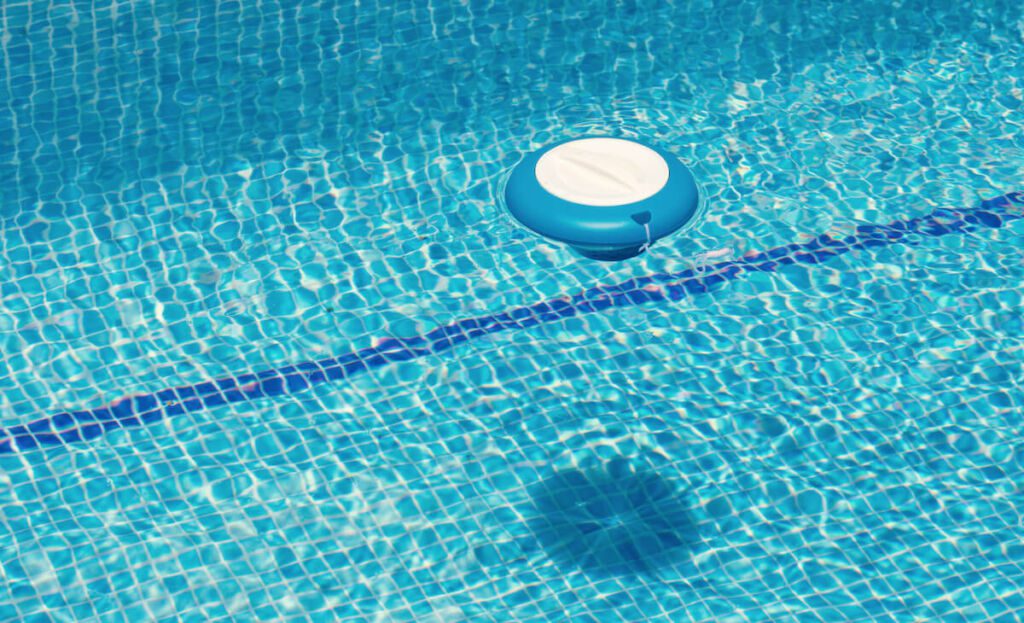Chlorine is key for clear, protected & healthy pool water, but do you know how much chlorine to add to a pool?
Like most swimming pool owners, you want your pool to have crystal-clear water that’s always ready for swimming. But did you know that the secret to keeping your water clear and sparkling lies in knowing how much chlorine to add to a pool and which sanitation systems to use?
With so many options for chlorine treatments, tablets and additional sanitation alternatives on the market, it’s easy to get confused about how to use chlorine to keep your pool hygienic without misusing or overusing it. In this post, we’ll walk you through the dos and don’ts of chlorine levels – so you can keep your pool water sparkling all summer long.
Why do I need chlorine in my pool?
When it comes to keeping your backyard oasis clean and safe for swimming, few chemicals are as crucial as chlorine. Chlorine is an essential part of keeping pool water safe for an enjoyable swimming experience. Without pool chlorine, bacteria and other germs can quickly spread, causing illness and lowering water clarity. It’s important to make sure that your swimming pool chlorine levels are properly monitored and maintained to ensure a safe and healthy environment for swimmers.
Chlorine is usually added to pool water in the form of a chemical like calcium hypochlorite, sodium hypochlorite or lithium hypochlorite. When added to your swimming pool water, these chemicals form a disinfectant compound known as hypochlorous acid. This acid is highly effective at killing algae, bacteria and other germs, while keeping your swimming pool safe and clean.
Ultimately, chlorine is an essential part of keeping your swimming pool safe, clean and inviting.
While chlorine is an essential part of pool maintenance, it’s critical to use it in moderation. Too much unnecessary chlorine use can pose health risks for swimmers, including eye irritation, irritated skin and even respiratory issues.
So, what health risks are associated with chlorine in swimming pools?
What happens if my pool has too much chlorine?
While chlorine can be a key player in keeping your pool clear, clean and safe for swimming, it’s crucial to use smart and sparingly. Excessive chlorine in swimming pools can be very unhealthy for swimmers. Chlorine is effective in killing bacteria and viruses, but it can also produce harmful by-products that can aggravate your senses and harm your health.
Despite popular belief, “pool” odor, red eyes and skin irritation is not from chlorine, but rather chloramines or combined chlorine. These chloramines are the disinfection by-product (DBP) of pool chlorine reacting to organic material in the water, like sweat, skin oils, lotions and sunscreen.
When you have too much chlorine in highly-used pool water, toxic chloramines will form and cause unpleasant odors, burning eyes, skin redness and itching. Chloramine irritation makes swimming particularly uncomfortable for those with rashes, eczema and other skin conditions. Long-term exposure to chloramines in pool water and the surrounding air can exacerbate allergies and asthma and result in respiratory issues, like bronchitis and Lifeguard Lung. In extreme cases, chloramines and other DBPs have been linked to increased risk of lung, bladder and other types of cancer.
It’s also important to note that chlorine and salt water pool systems alone can’t protect you from all unwanted contaminants and illnesses, like chlorine-resistant Cryptosporidium or legionnaires.
How can I reduce the need for pool chlorine?
If you want protection from harmful chloramines and chlorine-resistant illnesses, consider installing a chlorine-alternative pool sanitation system. The best way to lower the need for chlorine is to use an alternative pool system that can do the hard sanitation and oxidation work that chlorine and salt alone can’t. Contrary to its name, “chlorine alternative” pool sanitation systems are usually used in addition to a chlorine or salt water pool system. Salt water pool systems can benefit from adding alternative systems because they’re chlorine-based sanitizers and work by forming sodium hydroxide (NaOH) and hydrochloric acid (HCl).
While many options are available, very few alternative pool sanitizers are proven effective to scale from 200-gallon hot tubs to 2-million-gallon wave pools – like chlorine can. Following the chlorine shortages that began in 2020, Hydroxyl-Based AOP is considered the best practice for alternative or supplemental sanitation in pools, hot tubs, water parks of all sizes.
Hydroxyl-Based AOP pool systems deliver strong sanitation power that lowers the need for chlorine. As an AOP (advanced oxidation process) system, it sanitizes with hydroxyl radicals, the most oxidative compounds available for recreational water treatment, surpassing chlorine, bromine and ozone. In addition to minimizing chlorine and chloramines, a main advantage of Hydroxyl-Based AOP is that it’s proven by university labs to destroy harmful chlorine-resistant Cryptosporidium.
For home pools, Hydroxyl-Based AOP systems are compact, weatherproof and wall-mounted with air tubing connecting the system to the pool plumbing. Hydroxyl-Based AOP pool systems work by pulling air in, treating it and injecting it into the pool plumbing to create high concentrations of hydroxyl radicals. In the pool plumbing, these hydroxyls destroy unwanted bacteria and contaminants on contact – so you aren’t swimming in a harsh chemical sanitizer. So, what’s left is clear, healthy and soft-feeling water that only needs precautionary drinking-water chlorine levels or less. Unlike other AOP pool systems that combine ozone and UV, Hydroxyl-Based AOP pool systems use a one-of-a-kind AOP technology that’s patented and only available by Clear Comfort.
How much chlorine to add to a pool
No matter what sanitation method you use, pool industry standards recommend using at least a low residual level of chlorine in your pool for preventative protection and hygiene. To comply with health codes, commercial aquatic facilities and water parks are required to have a minimum chlorine level in the water at all times. With the right level of chlorine for your swimming pool, your water can still be kept soft, fresh-feeling and protected from chloramine-related health risks.
For your home swimming pool, the right chlorine levels depend on various factors, including:
- Type of sanitizer(s) used, including chlorine-based and chlorine alternatives
- Sanitizer concentration
- Water in gallons and flow rate GPM (gallons per minute)
- Weather and temperature
- Number of swimmers and frequency of use
- Environmental factors, like exposure to the sun, wind and organic materials
- Other water chemistry levels, like pH and alkalinity
- Type of filtration system
- Type of surface and material
- Water source and quality
Remember, it’s important to regularly test and adjust chlorine levels to maintain proper sanitation and water quality. Consulting a pool service professional is always encouraged to ensure safe and optimal levels for swimmers.
In general, home pools should adhere to the following typical free chlorine ranges in parts per million (ppm).
- For swimming pools using a chlorine-based sanitation system:
- Minimum free chlorine level: 1 ppm
- Maximum free chlorine level: 6 ppm
- Ideal free chlorine range: 2 – 4 ppm
- Typical free chlorine range: 3 – 5 ppm
- Typical free chlorine range with added Hydroxyl-Based AOP sanitizer: .5 – 1.5 ppm (residual level)
To learn more about the difference between free, combined chlorine and total chlorine, check out our blog here.
Since AOP doesn’t produce chlorine, it’s a recommended best practice to use a Hydroxyl-Based AOP pool system with a salt water pool system for minimal maintenance, maximum quality and optimum protection. Adding a Hydroxyl-Based AOP pool system allows you to minimize the need for chlorine to the lowest possible levels – with additional protection beyond chlorine’s capabilities. These levels are typically less than the chlorine found in your home’s water sources for drinking, bathing and showering.
If you want pool water that’s fresh, healthy and ready for swimming, use chlorine smart and sparingly to avoid toxic chloramines from misuse or overuse. Ultimately, the addition of a chlorine-alternative sanitation system, like a Hydroxyl-Based AOP pool system, is the best practice for optimal, effective and low chlorine levels that don’t sacrifice protection.
With the right systems, regular testing and adjustments, the ideal chlorine levels will help your pool crystal-clear, healthy and enjoyable all summer long.






